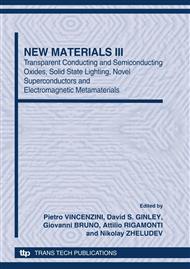p.9
p.16
p.25
p.31
p.36
p.43
p.49
p.55
p.65
Extraordinary Stability of Structural and Electronic Properties of Tin Oxide Nanoparticles Formed by Soft Chemistry
Abstract:
Powders of tin dioxide (SnO2) have been prepared by two different modifications of wet chemical synthesis, i.e. (i) by conventional hydrolysis of tin chloride dissolved in aqueous ammonia solution and (ii) by precipitation from tin chloride dissolved in aqueous hydrazine monohydrate (N2H4*H2O) solution. The prepared gels were dried and then annealed at different temperatures varied from 300 to 700 oC in order to form nanocrystals. Structure and optical properties of the samples were investigated by using X-ray diffraction, transmission electron microscopy, thermoprogrammable hydrogen reduction, low temperature nitrogen adsorption method, photoluminescence, infra-red absorption, Raman spectroscopy, and X-ray photoelectron spectroscopy. The samples prepared by hydrazine-based method are characterized by surface area about 127-188 m2/g with high sintering resistance. The optical spectroscopy data revealed pure crystallinity and high defect concentration for the samples prepared by hydrazine-based method. The experimental results are discussed in view of different states of chemisorbed oxygen on SnO2 nanocrystal surfaces, which determine electronic and optical properties of the prepared samples.
Info:
Periodical:
Pages:
36-42
Citation:
Online since:
October 2010
Price:
Сopyright:
© 2010 Trans Tech Publications Ltd. All Rights Reserved
Share:
Citation:


